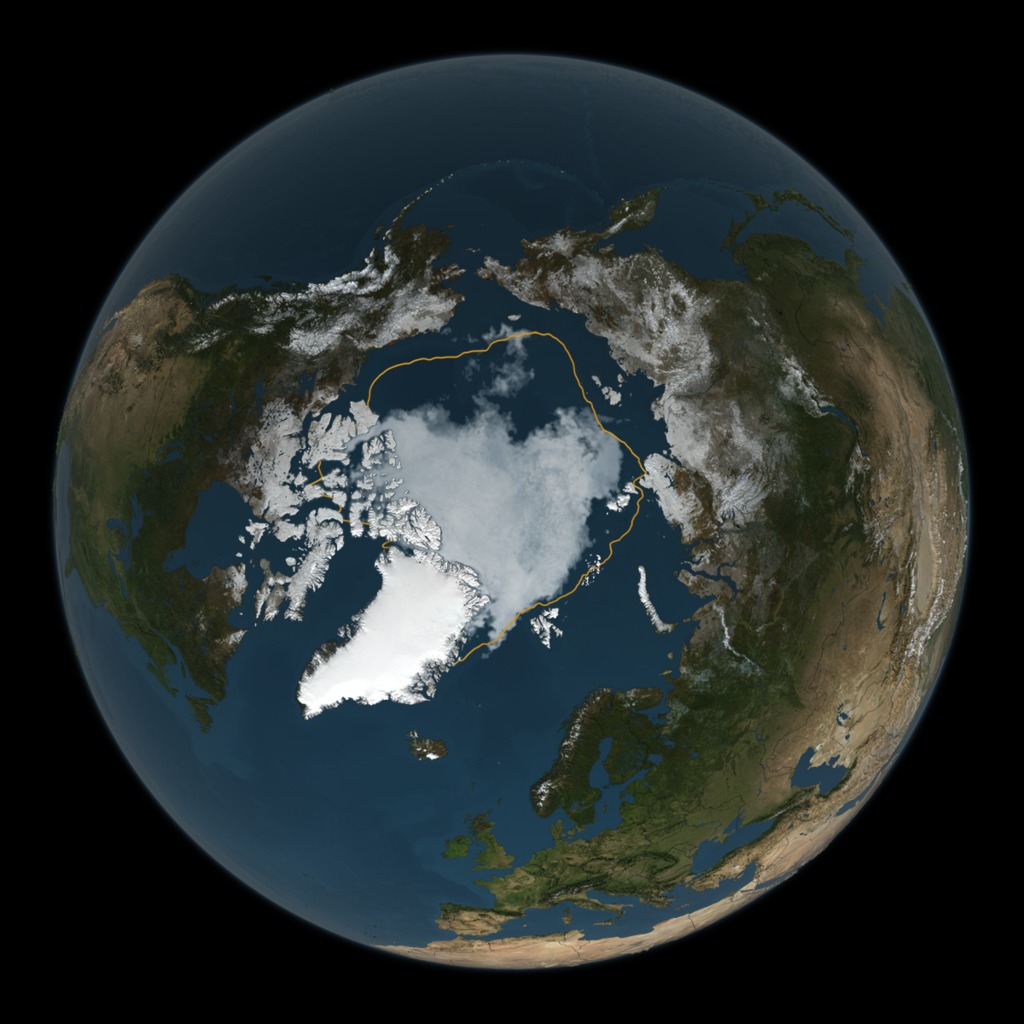Earth
ID: 4521

Satellite-based passive microwave images of the sea ice have provided a reliable tool for continuously monitoring changes in the Arctic ice since 1979. Every summer the Arctic ice cap melts down to what scientists call its "minimum" before colder weather begins to cause ice cover to increase. The first six months of 2016 have been the warmest first half of any year in our recorded history of surface temperature (which goes back to 1880). Data shows that the Arctic temperature increases are much bigger, relatively, than the rest of the globe.
The Japan Aerospace Exploration Agency (JAXA) provides many water-related products derived from data acquired by the Advanced Microwave Scanning Radiometer 2 (AMSR2) instrument aboard the Global Change Observation Mission 1st-Water "SHIZUKU" (GCOM-W1) satellite. Two JAXA datasets used in this animation are the 10-km daily sea ice concentration and the 10 km daily 89 GHz Brightness Temperature.
This image shows the Arctic sea ice on September 10, 2016 when the ice reached its minimum extent. The opacity of the sea ice is derived from the sea ice concentration where it is greater than 15%. The blueish white color of the sea ice is derived the AMSR2 89 GHz brightness temperature.
Image of the Arctic Sea ice - September 10, 2016

The Japan Aerospace Exploration Agency (JAXA) provides many water-related products derived from data acquired by the Advanced Microwave Scanning Radiometer 2 (AMSR2) instrument aboard the Global Change Observation Mission 1st-Water "SHIZUKU" (GCOM-W1) satellite. Two JAXA datasets used in this animation are the 10-km daily sea ice concentration and the 10 km daily 89 GHz Brightness Temperature.
This image shows the Arctic sea ice on September 10, 2016 when the ice reached its minimum extent. The opacity of the sea ice is derived from the sea ice concentration where it is greater than 15%. The blueish white color of the sea ice is derived the AMSR2 89 GHz brightness temperature.
Visualization Credits
Lead Visualizer:
Cindy Starr (Global Science and Technology, Inc.)
Scientists:
Josefino Comiso (NASA/GSFC)
Walt Meier (NASA/GSFC)
Sr. Data Analyst:
Robert Gersten (Wyle Information Systems)
Technical Support:
Laurence Schuler (ADNET Systems, Inc.)
Ian Jones (ADNET Systems, Inc.)
Project Support:
Joycelyn Thomson Jones (NASA/GSFC)
Leann Johnson (Global Science and Technology, Inc.)
Eric Sokolowsky (Global Science and Technology, Inc.)
Cindy Starr (Global Science and Technology, Inc.)
Scientists:
Josefino Comiso (NASA/GSFC)
Walt Meier (NASA/GSFC)
Sr. Data Analyst:
Robert Gersten (Wyle Information Systems)
Technical Support:
Laurence Schuler (ADNET Systems, Inc.)
Ian Jones (ADNET Systems, Inc.)
Project Support:
Joycelyn Thomson Jones (NASA/GSFC)
Leann Johnson (Global Science and Technology, Inc.)
Eric Sokolowsky (Global Science and Technology, Inc.)
Please give credit for this item to:
NASA's Scientific Visualization Studio
NASA's Scientific Visualization Studio
Short URL to share this page:
https://svs.gsfc.nasa.gov/4521
Data Used:
Note: While we identify the data sets used in these visualizations, we do not store any further details nor the data sets themselves on our site.
Keyword:
NASA Science >> Earth
https://svs.gsfc.nasa.gov/4521
Data Used:
Terra and Aqua/MODIS/Blue Marble: Next Generation also referred to as: BMNG
2004
Credit:
The Blue Marble data is courtesy of Reto Stockli (NASA/GSFC).
The Blue Marble data is courtesy of Reto Stockli (NASA/GSFC).
SHIZUKU (GCOM-W1)/AMSR2/10 km Daily Sea Ice Concentration
Observed Data - Japan Aerospace Exploration Agency - 09-10-2016
Credit:
AMSR2 data courtesy of the Japan Aerospace Exploration Agency (JAXA).
AMSR2 data courtesy of the Japan Aerospace Exploration Agency (JAXA).
SHIZUKU (GCOM-W1)/AMSR2/10 km Daily 89 GHz Brightness Temperature
Observed Data - Japan Aerospace Exploration Agency - 09-10-2016
Credit:
AMSR2 data courtesy of the Japan Aerospace Exploration Agency (JAXA).
AMSR2 data courtesy of the Japan Aerospace Exploration Agency (JAXA).
Keyword:
NASA Science >> Earth











